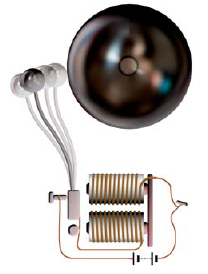Extra Questions for Class 7 Science Chapter 14 Electric Current And Its Effects
Extra questions for Class 7 Science Chapter 14 Electric Current And Its Effects with answers is given below. Our subject expert prepared these solutions as per the latest NCERT textbook. These questions will be helpful to revise the all topics and concepts. CBSE Class 7 extra questions are the most simple and conceptual questions that are prepared by subject experts for the students to study well for the final exams. By solving these extra questions, students can be very efficient in their exam preparations.
Electric Current And Its Effects Class 7 Science Extra Questions and Answers
Very Short Extra Questions and Answer
1. What is a circuit diagram?
Answer: It is a symbolic representation of an electric circuit.
2. Which property of a conducting wire is utilised in making electric fuse?
Answer: Low melting point of the wire.
3. What is electric current?
Answer: Electric current is flow of electrons.
4. Why does light bulb get hot?
Answer: Light bulb gets hot due to heating effect of the electric current.
5. Who discovered magnetic effect of current?
Answer: Hans Christian Oersted discovered magnetic effect of current.
6. How does a bulb glow?
Answer: In the bulb there is a thin wire, called the filament, which glows and gives off light when an electric current passes through it.
7. Write some uses of battery.
Answer: Many devices such as torches, transistors, toys, TV remote controls, use batteries.
8. Which wire used in electric heater and why?
Answer: Nichrome wire is used in electric heater because it has a high melting temperature.
9. What is filament?
Answer: In the bulb there is a thin wire, called the filament, which glows when an electric current passes through it.
10. Is it possible for a wire to melt and break? Why?
Answer: Yes, if a large current passes through a wire, the wire may become so hot that it may even melt and break.
Short Extra Questions and Answers
1. What is the heating effect of the electric current?
Answer: The wire gets hot when an electric current passes through it. This is the heating effect of the electric current.
2. Who invented electric bulb?
Answer: The credit for the invention of the electric bulb is usually given to Thomas Alva Edison, though others before him had worked on it.
3. What are the uses of heating effect of electric current?
Answer: Electrical appliances, such as immersion heaters, hotplates, irons, geysers, electric kettles, hair dryers uses of heating effect of electric current.
4. Explain the symbol of electric cell.
Answer: In the symbol of the electric cell, the longer line represents the positive terminal and the thicker, shorter line represents the negative terminal.
5. Name any two effects of electric current.
Answer: The two effects of electric current are:
- Heating effect of electric current
- Magnetic effect of the electric current
6. Why are fuse wires not used in circuit containing electric cell?
Answer: Fuse wires are not used in circuit containing electric cell because the amount of current follow is low and if the circuit breaks there is no risk of fire.
7. What is an electric circuit?
Answer: The electric circuit provides a closed path for electricity to pass between the two terminals of the electric cell. The bulb glows only when current flows through the circuit.
8. We could not see element in electrical appliances. Give reason.
Answer: We could not see element in electrical appliances because electrical appliances, such as immersion heaters, hotplates, irons, geysers, electric kettles, hair dryers, have elements inside them.
9. Why a fused bulb does not glow?
Answer: A break in the filament of an electric bulb means a break in the path of the current between the terminals of the electric cell. Therefore, a fused bulb will not glow as current does not passes through its filament.
10. Sometimes the cells are placed side by side. Then how are the terminals of the cells connected?
Answer: There is usually a thick wire or a metal strip connecting the positive terminal of one cell to the negative terminal of the next cell.
11. Why should we look for ISI mark on electrical appliances?
Answer: Before buying any electrical appliance we should look for ISI mark because this mark ensures that the appliance is safe and wastage of energy is the minimum.
12. On what factors does the heat produced in a wire depend?
Answer: The amount of heat produced in a wire depends on its material, length and thickness. Thus, for different requirements, the wires of different materials and different lengths and thicknesses are used.
13. What is battery? How can it be made using cells?
Answer: A combination of two or more cells is called a battery. Battery can be made by connecting two or more cells together. The positive terminal of one cell is connected to the negative terminal of the next cell.
14. Do you think an electromagnet can be used for separating plastic bags from a garbage heap? Explain.
Answer: No, an electromagnet cannot be used for separating plastic bags from a garbage heap because plastic bag is a non-magnetic material and will not be attracted by an electromagnet.
Long Extra Questions and Answers
1. What are electromagnets?
Answer: A core of magnetic material (such as iron) surrounded by a coil of wire behaves like a magnet when electric current flows through it. When the electric current is switched off, the coil generally loses its magnetism. Such coils are called electromagnets.
2. How does a heating element work in an electric heater?
Answer: An electric room heater or an electric heater used for cooking. All these contain a coil of wire. This coil of wire is called an element. When these appliances are switched on after connecting to the electric supply, their elements become red hot and give out heat.
3. What is MCB and what is it used for?
Answer: These days Miniature circuit breakers (MCBs) are increasingly being used in place of fuses. These are switches which automatically turn off when current in a circuit exceeds the safe limit. We can turn them on and the circuit is once again complete.
4. An electrician is carrying out some repairs in your house. He wants to replace a fuse by a piece of wire. Would you agree? Give reasons for your response.
Answer: No, electrician should not replace a fuse by a piece of wire because for fuse, wires made from some special materials are used so that it melt quickly and break when large electric currents passes through them.
5. What are the reasons for excessive currents in the electrical circuits?
Answer: One reason for excessive currents in electrical circuits is the direct touching of wires. This may happen if the insulation on the wires has come off due to wear and tear. This may cause a short circuit. Another reason for excessive current can be the connection of many devices to a single socket. This may cause overload in the circuit.
6. An electric bulb results in wastage of electricity. Comment
Answer: An electric bulb is used for light but it also gives heat. This is not desirable. This results in the wastage of electricity. This wastage can be reduced by using fluorescent tube lights in place of the bulbs. Compact fluorescent lamps (CFLs) also reduce wastage and can be fixed in the ordinary bulb holders.
7. What is the use of electrical fuse?
Answer: In all buildings fuses are inserted in all electrical circuits. There is a maximum limit on the current which can safely flow through a circuit. If by accident the current exceeds this safe limit, the wires may become overheated and may cause fire. If a proper fuse is there in the circuit, it will blow off and break the circuit. A fuse is thus a safety device which prevents damages to electrical circuits and possible fires.
8. The following Fig. shows four cells fixed on a board. Draw lines to indicate how you will connect their terminals with wires to make a battery of four cells.
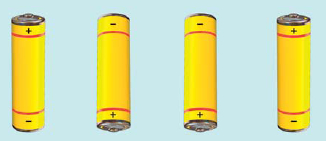
Answer:
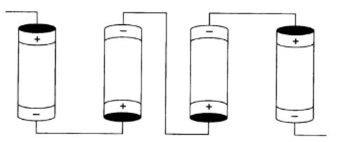
9. What are the uses of electromagnets?
Answer: The electromagnets can be made very strong and can lift very heavy loads. The end of such a crane has a strong electromagnet attached to it. The electromagnets are also used to separate magnetic material from the junk. Doctors use tiny electromagnets to take out small pieces of magnetic material that have accidentally fallen in the eye. Many toys also have electromagnets inside them. Electromagnets are also used in electric bells.
10. When the current is switched on through a wire, a compass needle kept nearby gets deflected from its north-south position. Explain.
Answer: We know that the needle of a compass is a tiny magnet, which points in north-south direction. When we bring a magnet close to it, the needle gets deflected. We have also seen that compass needle gets deflected when the current flows in a nearby wire. This is so because when electric current passes through a wire, it behaves like a magnet. This is the magnetic effect of the electric current.
11. Write the key points about electric circuit.
Answer:
- Notice that the key or switch can be placed anywhere in the circuit.
- When the switch is in the ‘ON’ position, the circuit from the positive terminal of the battery to the negative terminal is complete. The circuit is then said to be closed and the current flows throughout the circuit instantly.
- When the switch is in the ‘OFF’ position, the circuit is incomplete. It is said to be open. No current flows through any part of the circuit.
12. Will the compass needle show deflection when the switch in the circuit shown below is closed?
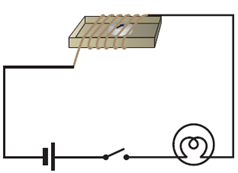
Answer: No, the compass needle will not show deflection when the switch in the circuit shown above is closed because compass needle shows deflection only when current passes through the wire.
13. Draw in your notebook the symbols to represent the following components of electrical circuits: connecting wires, switch in the ‘OFF’ position, bulb, cell, switch in the ‘ON’ position, and battery.
Answer:
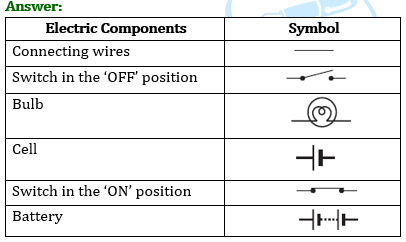
14. In the circuit shown in the below Fig.
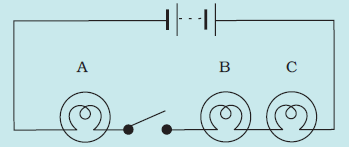
(i) Would any of the bulbs glow when the switch is in the ‘OFF’ position?
(ii) What will be the order in which the bulbs A, B and C will glow when the switch is moved to the ‘ON’ position?
Answer: (i) No, bulb will not glow when the switch is in the ‘OFF’ position because current does not flow through the circuit.
(ii) All the bulbs will glow simultaneously when the switch is moved to the ‘ON’ position.
15. Draw the circuit diagram to represent the circuit shown below.
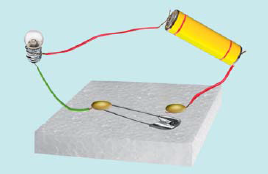
Answer: Here, the switch is in the ‘OFF’ position as one of the board pin is not attached to the safety pin. Thus, the circuit is incomplete. It is said to be open and no current flows through any part of the circuit. Bulb glows only when the switch is in the ‘ON’ position and the electric circuit is closed.
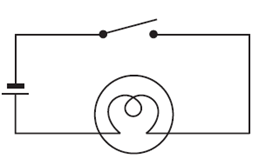
16. The bulb in the circuit shown in Fig. does not glow. Can you identify the problem? Make necessary changes in the circuit to make the bulb glow.
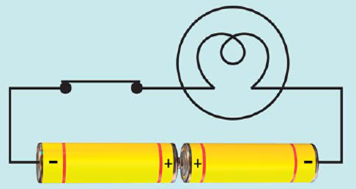
Answer: The bulb in the circuit is not glowing because the two cells are not connected properly. In order to make the bulb glow, the negative terminal of one cell should be connected to positive terminal of the other cell.
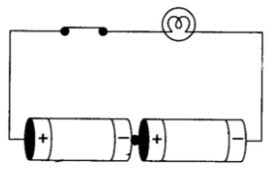
17. Zubeda made an electric circuit using a cell holder shown in Fig., a switch and a bulb. When she put the switch in the ‘ON’ position, the bulb did not glow. Help Zubeda in identifying the possible defects in the circuit.
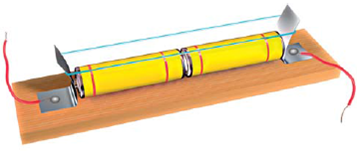
Answer: Possible defects are:
- Rubber band used may not be tight enough to hold the metal strips tightly. It is necessary that the rubber bands hold the metal strips tightly.
- The two cells may not be connected properly. The negative terminal of one cell should be connected with the positive terminal of the other cell.
- The two cells may not be in proper contact. Current will not flow if circuit is not complete.
- The bulb may be fused. Fuse bulb do not complete the circuit. Hence bulb will not glow.
18. Write an experiment to show the magnetic effect of current.
Answer: Take the cardboard tray from inside a discarded matchbox. Wrap an electric wire a few times around the cardboard tray. Place a small compass needle inside it. Now connect the free ends of this wire to an electric cell through a switch. Now, move the switch to the ‘ON’ position. We will observe that compass needle gets deflected when the current flows in a nearby wire. So, when electric current passes through a wire, it behaves like a magnet. This is the magnetic effect of the electric current.
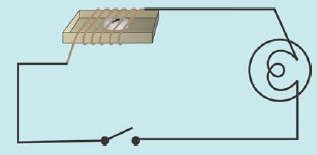
19. Write an experiment to make an electromagnet.
Answer: Take around 75 cm long piece of insulated (plastic or cloth covered or enamelled) flexible wire and an iron nail, say about 6–10 cm long. Wind the wire tightly around the nail in the form of a coil. Connect the free ends of the wire to the terminals of a cell through a switch. Place some pins on or near the end of the nail. Now switch on the current. The pins cling to the end of the nail. The coil in the above activity behaves like a magnet when electric current flows through it. When the electric current is switched off, the coil generally loses its magnetism. Such coils are called electromagnets.
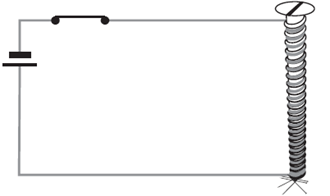
20. How does an electric bell work?
Or
Explain the working of an electric bell.
Answer: The circuit of an electric bell consists of a coil of wire wound on an iron piece. The coil acts as an electromagnet. An iron strip with a hammer at one end is kept close to the electromagnet. There is a contact screw near the iron strip. When the iron strip is in contact with the screw, the current flows through the coil which becomes an electromagnet. It, then, pulls the iron strip. In the process, the hammer at the end of the strip strikes the gong of the bell to produce a sound.
However, when the electromagnet pulls the iron strip, it also breaks the circuit. The current through the coil stops flowing. The coil is no longer an electromagnet. It no longer attracts the iron strip. The iron strip comes back to its original position and touches the contact screw again. This completes the circuit. The current flows in the coil and the hammer strikes the gong again. This process is repeated in quick succession. The hammer strikes the gong every time the circuit is completed. This is how the bell rings.
